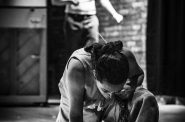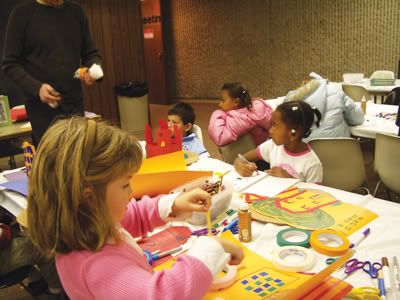Behind the curtain
This month, to an even greater extent than usual, you can leaf through the pages of VITAL and find calendar listings, phone numbers, websites and profiles of the people that power the ships, as well as evidence, photographic and otherwise, of creative output. With a little imagination you can envision a setting: a proscenium stage, a row of footlights, dusty makeup rooms and wardrobes stuffed with spangled costumes. You might think about musical instruments or ballet shoes, or you might imagine the barely-controlled chaos of ticket offices and sales departments.
But what else happens inside a performance company? And how wide of an audience do arts groups reach? What is their relevance or value to the wider world?
The truth is, with public schools more strapped for cash than ever and cultural resources dwindling, arts organizations are sometimes a community’s most powerful force for education, outreach and enrichment resources. Members and affiliates of the United Performing Arts Fund alone touch over a million people every year, including more than 400,000 area children, according to UPAF Vice President of Community Relations and Marketing Linda Edelstein. Here, four major Milwaukee arts institutions share their most compelling initiatives for the coming season and the value they’ve brought to the city.
Training and growth
It’s a big year for the Milwaukee Ballet, whose acclaimed Ballet School is rated among the very best in the nation. In late August the School opened its largest branch at the Sendik’s Towne Centre in Brookfield, and this fall, the ink should be dry on the accreditation forms sent in to the National Association of Schools for Dance. If accredited, the Milwaukee Ballet School – established in 1975 – will be the only dance institution in the region that has met the NASD’s standards.
But the Ballet’s outreach programming extends beyond sprung dance floors, lofty studios and kids in tutus. Their education programs alone reach over 20,000 kids a year through in-school performances, workshops and collaborations with other arts organizations.
Merging training, performance, enrichment and the continuity that a successful arts education program requires, Relevé, an inner city youth dance program, provides ballet training to over 175 students at four MPS elementary schools: Allen-Field, Dover, Maple Tree and Vieau. Children start small with once-a-week, in-school ballet classes in 3rd grade and advance through 4th and 5th grade with training at the Milwaukee Ballet studios in the Peck Center. All of their dancewear is provided for free, and their study is enriched with free tickets to shows at the Ballet, in-school performances, meeting with company dancers and end-of-the-year recitals.
Training young people doesn’t have to stop with school kids. Art depends on fresh faces and the collision of new ideas with established practices to stay vital. In the Florentine Opera’s 75th Anniversary Season, the company launches its Studio Artists Program, a residency designed to nurture promising talent by providing experience, training and growth opportunities to emerging artists. The studio artists will sing supporting roles during the regular season and perform at special functions.
They’ll also be driving the engine of the Florentine’s in-school touring opera program, an initiative that brings classical opera – sung in English – into schools all over Metro Milwaukee. This year, the singers perform Pinocchio by arts educator John Davies, with the classic story set to the familiar music of Mozart, Donizetti, Offenbach, Pergolesi, Sullivan and Verdi.
This year’s studio artists are soprano Greer Davis-Brown, mezzo Colleen E. Brooks, tenor Rafael Luquis and baritone Todd von Felker. The program runs from October 2008 through April 2009; catch an early glimpse of the emerging artists in a showcase concert at the Wilson Center on October 19.
Dynamic collaborations
Through Art Aloud – a collaborative program between the Milwaukee Public Libraryand the Milwaukee Art Museum that is 16 years in scope – kids come together to learn, play, make art and hear stories from librarians, teachers and local artists. Each week for nine weeks, more than 125 students participate at six different libraries around the city.
After the program, the students have “more of an interest in reading, in art projects, more interest in creativity … and social skill growth [like] self-esteem and confidence and working with other people,” says Sylvia Peine, Family Programs Coordinator at MAM.
Art Aloud serves a broad cross-section of the population; each semester, the program generally serves two libraries on the south side and four on the north side. Some libraries are located in communities with dense populations of homeschoolers, whose entire families participate.
“The kids learn to work with other people who are different,” says Peine. “[And] it allows them to be creative within a structure.”
Every Art Aloud student is invited to come to the Art Museum for a free tour with their family, and at the end of the program, they’re hosted at a Family Sunday where the art they’ve created during the semester is on display.
The Art Museum awards scholarships to two children in each program that they can use to take a class or attend art camp.
“We try to give [the children] as many opportunities to come to the Museum as possible,” she says. “It’s a really successful, well-received program. The kids love it, the parents love it, the teachers love it, the librarians love it.”
Danceworks’ anchor educational program similarly fosters creativity, confidence and scholastic achievement and bridges diverse communities. The Intergenerational Multi-Arts Project (IMAP) was in the works for years before it was officially branded three years ago.
IMAP brings together local fourth-throughsixth grade students with elders from senior centers. “It helps the kids, it helps the elders and it connects communities that would otherwise be isolated,” says Janet Lew Carr, Community Programs Coordinator at Danceworks.
“We use the tools of art to touch as many individuals that we can,” says Carr. “Not everyone is into creative movement, not everyone can do visual art, but somehow we all come out at the same place.”
IMAP culminates with Wide Sky, a “community dance documentary” that uses stories and experiences from the program as inspiration for the choreography, as well as multimedia features like video and photography.
In 2008-2009, IMAP’s theme is “Falling,” and the various forms falling can take – falling in love, falling asleep, falling from grace, the idea of fallout. Look for pieces exploring the climate of fear in the 1950s that some of the elder participants in the program may have lived through, as well as explorations of the fallout after the Vietnam war that Hmong participants in the program experienced.
Almost every local established arts group offers some enrichment programming or community- based outreach beyond its performance calendar. There are many incredible stories being written every day, right here in our own backyard. We would love it if you would share your account, either on behalf of your arts organization or from your personal experience. Write me at aelliott@vitalsourcemag.com and we’ll post your story on our website with this one. We can’t wait to hear from you! VS
Dance
-
New Riverwest Company, Production Impresses
 Feb 10th, 2020 by Brendan Fox
Feb 10th, 2020 by Brendan Fox
-
Milwaukee Ballet Show Remakes History
 Feb 10th, 2020 by Catherine Jozwik
Feb 10th, 2020 by Catherine Jozwik
-
Ballet Does Free Production of ‘Nutcracker’
 Dec 20th, 2019 by Richard Davis
Dec 20th, 2019 by Richard Davis



















